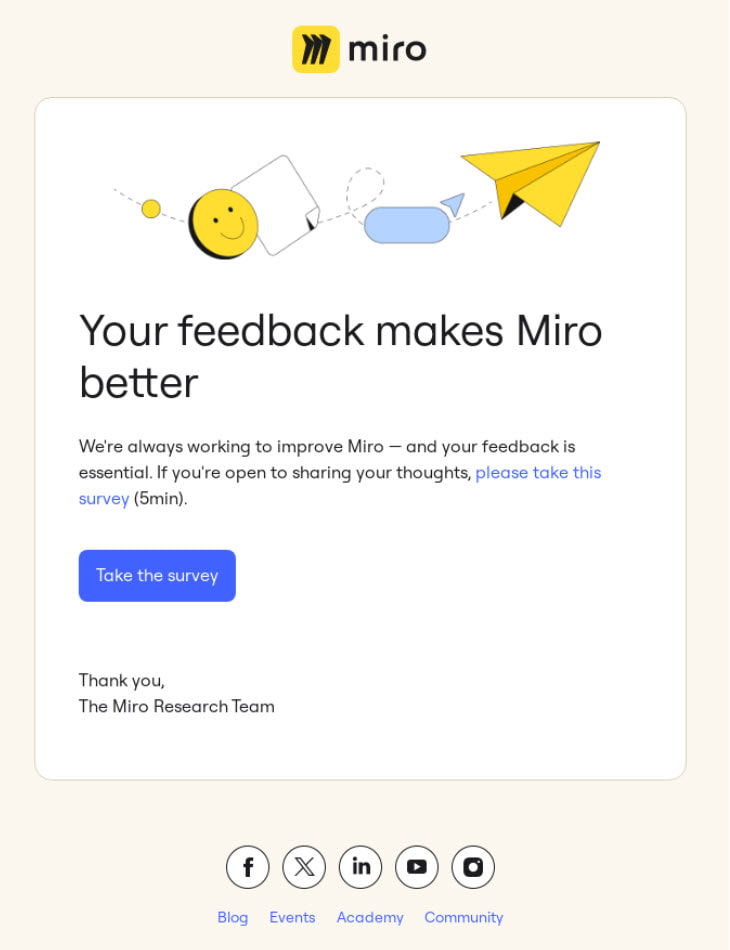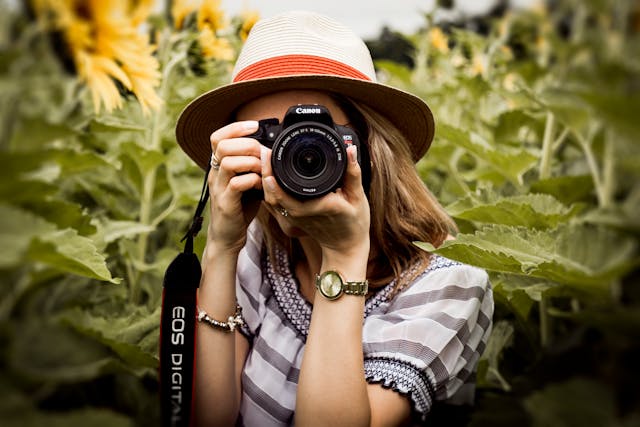|
Since the invention of electronic mail (commonly known as email), people have been using the technology to send and receive important information from colleagues, humorous chain mail, and personal communications from friends and family. Today, email is a major avenue for businesses to communicate with existing and potential customers. From welcome emails to reminders about abandoned carts, email keeps subscribers informed and engaged with the brands they love. What is email marketing? Email marketing is a marketing strategy that uses emails to generate measurable returns for your business. Marketing emails differ in a few ways from a typical email you might send to a relative or coworker. First, a marketing email is sent to a current or prospective customer. Second, while personal emails are often just relaying information, the goal of a marketing email is always to drive subscriber actions that benefit the business, such as signing up for an event or clicking through to a product page. You’ll achieve your business goals by delivering value to your readers, often through engaging content, coupons, and exclusive offers. Finally, while you may send out a personal email and move on immediately, marketing emails should be measured to see if readers are opening them and taking the desired action(s). Benefits of email marketing One of the top benefits of email marketing is that it helps you to keep in touch with your customers. Whether a simple “Thank you for subscribing,” a cheery “Welcome on board,” or a sincere Happy Birthday email, email is the easiest and most effective way to let your customers know you value them. Customers love it when a business treats them as individuals. That value should show in the emails you send, and the more value you provide to your customers, the more they’ll look forward to hearing from you. Getting them to engage with your call to action is more effortless when that happens. Studies show that email marketing outperforms other digital marketing channels, including social media and paid search. 1. Boost engagement & loyalty Email marketing is a powerful tool for boosting engagement and customer loyalty. By delivering personalized content and targeted email marketing campaigns, businesses can capture and keep the attention of recipients — driving higher open rates, click-through rates, and conversions. In your search to boost engagement through email marketing, you’ll discover the best digital marketing tool to fit your needs includes the ability to automate email marketing campaigns. Automation allows your business to better tailor your customer’s experience with your marketing messages and gives you time back in your schedule. Whether your user is extending their subscription or buying a new product, you can leverage email drip campaigns to engage customers during the renewal or new purchase process. Whenever a user leaves an unpurchased product in their cart, use email automation to send an abandoned cart email and let them know the product is still available for purchase. 2. Promote relevant content Email marketing opens up a communication line with your subscribers, potential customers, and loyalists to receive content that keeps them up-to-date about what’s happening with your business. As you craft content, you’ll want to provide expert advice, promote a new product line, or share customer testimonials to lend credibility to your brand and reassure your clientele. Remember, data is a friend to both your subscribers and your business. When you know where a customer fits into your email cycle, sending them content that’ll interest them and keep them engaged is easy. Email campaigns become especially handy when you are running a small business and have to be strategic about how you spend your time. Try targeting user segments based on which aspects of your service subscribers use most, recent purchases, or behaviors . 3. Help increase brand awareness Email marketing is a great way to develop your brand identity because it gives you a direct line to customers and potential customers while showcasing your voice, style, and mission. You’ll have an edge over your competitors once you create valuable content for the customer. Email marketing can also help you gauge subscriber and customer sentiment toward your brand. Use a survey to ask for feedback. Are customers happy with the content you’re providing? Would they like to learn something different? Once you know what interests them, you’ll know how to provide valuable email content. 4. Boost sales Email marketing offers equal opportunity to incite impulse purchases and drive careful consideration. Whatever your target audience looks like, you can use email marketing to encourage a first-time buyer to click “add to cart” or a long-time shopper to stay true to your brand. For new customers, you might consider:
To shoot for a repeat customer, try:
What are the types of email marketing? It’s important for businesses to choose the appropriate type of email marketing based on their goals, target audience, and the desired outcome of the campaign. Here are some common types:
This promotional email from DoorDash offers subscribers five free package deliveries. Image Source: DoorDash 2. Welcome Emails: Sent to new subscribers or customers, welcome emails aim to introduce the brand, set expectations, and provide valuable information. They can include a warm greeting, a brief company overview, and a call to action to encourage further engagement. 3. Newsletter Emails: Newsletters are regular emails sent to subscribers to provide updates, news, and valuable content. They can include industry insights, blog articles, product updates, or curated content to keep subscribers informed and engaged. 4. Abandoned Cart Emails: These emails are triggered when a customer adds items to their cart but doesn’t complete the purchase. Abandoned cart emails aim to remind customers of their unfinished purchases, offer incentives, and encourage them to complete the transaction. This abandoned cart email from PlayStation encourages a potential customer to take action on an abandoned cart. Image Source: PlayStation 5. Re-engagement Emails: Sent to inactive subscribers, re-engagement emails aim to win back their interest. They can include special offers, personalized recommendations, or surveys to better understand their preferences. 6. Transactional Emails: These emails are triggered by specific actions or transactions, such as order confirmations, shipping notifications, or password resets. While primarily informative, transactional emails can also include personalized recommendations or cross-sell opportunities. 7. Event Invitation Emails: Emails sent to invite subscribers to events, webinars, or workshops, these emails provide details about the event, registration links, and any special offers or incentives for attending. 8. Feedback or Survey Emails: These emails are sent to gather feedback from customers or subscribers. They can include surveys, polls, or feedback forms to collect valuable insights and improve the customer experience. This email from Miro asks subscribers to participate in a survey to provide valuable feedback to help them improve their product. Image Source: Miro Key email marketing stats and cost-effectiveness Email marketing is relatively cheap. Whether you do it yourself or through an email marketing provider, marketing to hundreds of customers via email will cost you peanuts compared to other advertising channels. With email marketing, you can send targeted emails based on what you know about your customers – such as likes, dislikes, content preferences, age, location, and buying patterns. A few key stats: → Email marketing has an average return of $36 for every dollar spent, so investing in email marketing can have some serious payoffs. → On average, abandoned cart emails have a 43.76% open rate, an 8.76% click-through rate, and a conversion rate of 10.7% → According to a 2022 Radicati Group study, there will be more than 4.48 billion email users by the end of 2024. In other words, over half of the people on this planet use email right now. That sounds crazy, doesn’t it? But think about it: whenever you register with a new website or sign up for an account, you must have an email address. Yes, you can log in with a social media account like Facebook, but you still need an email address to sign up for Facebook. Email is still the dominant form of communication, and smart businesses use email every day to turn prospects into customers. What’s more, email results are easy to measure. Constant Contact customers have real-time access to metrics like open rates, clicks, bounces, forwards, social shares, and more. Expert tips to know about email marketing 1. Choose an email marketing service provider If you’re serious about email marketing, you must work with an email marketing service provider. Working with a provider is the only way your business can leverage email marketing to deliver messages to large groups of contacts or subscribers effectively. You’ll also benefit from professional email templates, automation tools to help you expand, easy ways to manage and grow your email list, and tracking features showing how customers respond to your emails. 2. Gather contacts for your email marketing list Most businesses have some existing contacts when they start a mailing list. Think of the customers and people you already have a business relationship with. Maybe they’re contacts you email regularly, or you could start with a few supportive friends and family members. Don’t get discouraged, even if you’re building an email list completely from scratch. Start by putting a paper sign-up sheet near your register, adding an online sign-up form to your website, and encouraging your social media followers and loyal customers to sign up. Whatever you do, don’t purchase an email list. Email marketing management is all about building and nurturing relationships; connecting with a smaller list of quality contacts is more impactful than blasting out emails to contacts who haven’t consented to receive marketing emails from your business. 3. Set up your welcome email The first email a new subscriber should receive is the welcome email. Use your welcome emails to help your business build a relationship with your audience. Connect them to your brand voice, provide valuable content, and offer exclusive deals to set the tone for future customer experiences. Consider automating your welcome emails. New subscribers will be added to your welcome email list and receive content in a timely manner. 4. Write persuasive messages This tends to be one of the scariest steps for business owners. You don’t want to sound too sales-y or push too hard to get potential customers to buy your products, but at the same time, you want to convert them into paying customers. When thinking of email marketing campaign ideas, it helps to follow a repeatable process and break your message down into three crucial sections:
This simple three-step formula helps you stay focused so you can write more effective messages. 5. Use personalization in subject lines The subject line of your email is one of the first impressions someone gets from your brand, especially when you’re sending them an email for the first time. Using what you already know about the customer should be your first priority while sending email marketing campaigns. Your subject line should be short and snappy — around 40 characters. You can draw attention by asking a compelling question, including a deadline to increase urgency, or teasing your message. 6. Focus on customers, not your products Have you ever received a marketing email that didn’t feel relevant enough? Yeah, that can get a little annoying. An email cluttered with products or information that doesn’t provide the subscriber with value will cause them to lose interest in your email marketing and unsubscribe from your email list if the issue persists. When you’re dividing your readers into segments, make sure to remember what stage of the customer lifecycle they’re in. For example, they’re a new customer or someone who’s left something behind in their cart. A little extra effort when segmenting emails can go a long way. 7. Preview and test before you send Make sure the content you’re sending is grammatically correct and free of styling errors. Use the preview function in your email marketing software to view your content, check links and promo codes, and send test emails. Catch errors when they count, so you can provide a high quality email experience for your subscribers. 8. Track your results Email marketing doesn’t end with a send. You will want to track your open rate, click-through rate, unsubscribe rates, etc., and work to improve over time. You need to know which metrics will help you create a perfect email marketing strategy. These aren’t the only indicators of optimal email performance, but they’re a good start. Remember to A/B test different emails with different segments to see what works and what doesn’t. Learning from these metrics can help you define your goals and answer important questions like, “Are customers opening my emails?”, “Are they clicking?”, and “Do they care at all?” Knowing what works and what doesn’t help you save time, effort, and money. Start sending your emails with confidence! Create an email marketing strategy that fits within your budget and helps you to attract new customers. Take the first step by crafting a welcome email to introduce your brand and begin building a relationship with your subscribers. Frequently Asked Questions (FAQ) How should I measure the success of my email marketing campaign? While you might be inclined to focus on open rates, it’s not the only metric to look to when you’re measuring the success of your email marketing campaigns. Look to click-through rates and conversions, in addition to open rates, to help you determine if your email marketing campaigns were successful. How do I make sure my marketing emails avoid ending up in the spam folder? A couple of factors contribute to a high rate of email deliverability. From sender score to subject lines, you want to make sure your marketing emails are making it into the inbox and staying out of the spam folder. What’s the best structure for a marketing email? Typically every great marketing email has the following elements:
Source: https://www.constantcontact.com/
0 Comments
Key Takeaways
Behind every successful company is an entrepreneur who is deeply committed to their business and is passionate about their products and services. For new entrepreneurs, this passion is easy to sustain in the beginning when everything is new and exciting. There seems to be an endless flow of challenges, change, accomplishments, and milestones that keep you going. Unfortunately, seasoned entrepreneurs know that once this "new business smell" wears off, it can be difficult to stay passionate about the work every single day. As the company grows and entrepreneurs are sucked into the complexities and routine of the business, they often find themselves struggling to maintain the initial passion that fueled their venture. This doesn't mean that you have bad business. This is a natural cycle that every entrepreneur must overcome. Fortunately, there are ways that you can build a business model that centers around keeping that passion alive and well. 1. Set clear and ambitious goals In the early stages of building a business, entrepreneurs go through a whirlwind of quick accomplishments, such as landing their first client or reaching profitability. Once the business stabilizes and has consistent operations, it's easy to fall into the trap of the day-to-day routine. To keep the passion alive, entrepreneurs should always have clear objectives that they are working towards. It's important for these goals to be ambitious. If your goals aren't ambitious, there is a huge chance that you'll get bored and won't feel challenged. 2. Create a culture of innovation and improvement Stagnation is the most common reason why people stop feeling motivated and passionate about their work. As a business owner, you can drive a culture of innovation and consistent improvement. It doesn't matter how passionate you are about the business, a lack of passion in your team will drag down the organization. By discovering new products, services or ways of doing things, you can keep yourself and your team engaged in the business. Take the time to listen to your customers and use that as an opportunity to refine your current products or services. Change is a great way to combat monotony and keep your team passionate about the business. 3. Delegate thoughtfully Nothing kills passion faster than an entrepreneur spending three hours trying to find the typo in their accounting records because they wanted to do the bookkeeping themselves instead of hiring a professional. Running a business isn't always fun, but it can be more enjoyable if you allow yourself and your team to avoid tasks they hate or aren't good at. Instead of randomly assigning responsibilities, carefully consider the strengths and weaknesses of everyone on the team. By playing to everyone's strengths, you can delegate activities in a way that keeps people excited about their work every day. 4. Permit creative outlets Part of the reason why new entrepreneurs can stay passionate about their ventures is because they are doing new and exciting things. Keeping your passion alive may simply require allowing creative outlets, even if they aren't necessarily business-critical. Give yourself and the team the opportunity to learn new skills and cross-train in different roles. This will help strengthen the business and provide an opportunity to step back from the monotonous day-to-day activities. Sustaining passion over time Building a culture and business model that is passion-centric is essential. However, despite all of these efforts, it can be challenging to maintain the excitement over many years. Here are some other routines and methods entrepreneurs can leverage to sustain their passion long-term.
Remember that passion is the reason you started your business in the first place. For this reason, it's the most important ingredient to keep your company moving forward and getting the most enjoyment out of your work. Source: https://www.entrepreneur.com
Key Takeaways
Many promising entrepreneurs and business owners seek investment, making it tough to convince someone to invest in their idea/startup. As a result, some individuals tend to exaggerate the quality of their ideas or products. If the venture succeeds and generates substantial profits, investors are usually satisfied. However, dissatisfaction may arise if things don't go as planned—and they do a lot of times! Fundraising is a long process that may take months before making any decision. Why months? Because every responsible fund conducts due diligence, delving deep into the startup and analyzing every aspect of it takes time. Some funds also attract external experts – we use this practice at Vibranium.VC. Why dishonesty is so tempting The deceptive temptation to take shortcuts is often based on a desire to present the startup in the best light possible, attracting investors and customers with an idealized version of reality. However, this slippery slope can lead to potential pitfalls, where one small untruth snowballs into a catastrophic downfall for a startup. Back in fall 2023, we were considering one startup for potential investment, conducted analysis, and held interviews — standard procedures for every potential investment we make. The company was making about $2 million in annual revenues, which was growing and positive. But we felt that there was something off; every time we asked for DEMO access to the platform, the founder would throw a fit, not wanting to cooperate. Even though, during our calls, the founder would operate a demonstration showing how the platform creates value for its customers,. So, we decided to conduct additional technical due diligence with two different expert teams. It turned out that we were shown an excellent Figma design all this time without an actual platform behind it. This project was a classic "fake it till you make it," and it was a deal breaker for us. We can understand that sometimes MVP is still in the process of making, but a deliberate lie that the revenues generated in the company come from nonexisting platforms was a no-go for us. Entrepreneurs may underestimate the consequences of dishonesty, believing that the ends justify the means. Yet, the truth has a way of revealing itself, and when it does, the repercussions can be severe, from ruined reputations to legal consequences. Giving in to the temptation to be deceptive can seriously harm the foundation of a startup. Turn the truth into a strategic asset Statistics indicate that, on average, the partnership between an investor and a startup lasts longer in the USA than a marriage – more people divorce faster than investors and startups part ways, achieving exit. Based on my experience, honesty emerges as a powerful strategic asset for entrepreneurs. Successful businesses have thrived on transparency and building trust with customers, investors, and employees. Honesty is not just a moral imperative but a smart business move that fosters long-term relationships. Several examples in the business world showcase the impact of truth as a strategic asset. Even when the news is not entirely positive, companies that openly communicate their challenges and successes often gain respect and loyalty from their stakeholders. By being forthright about shortcomings or setbacks, entrepreneurs can build a foundation of trust that withstands the test of time. When an investor has to decide in complex startup situations, for example, to support the startup or not for the second or third time, if there is no trust, the investor is likely not to support the startup because they will already feel deceived. Therefore, it is very important to embed these relationships from the very beginning on the principles of transparency, openness, and honesty. These basic things are important because they form the foundation for future years of relationships and communication between the investor and the startup. There have been cases where some of our startups needed bridge rounds, and we were ready to support them because they were honest about their situations and what they needed. Navigating the gray areas In the complex entrepreneurship landscape, ethical dilemmas often arise in grey areas. A gray area is an area or situation in which it is difficult to judge what is right and wrong. Entrepreneurs face tough decisions that test their commitment to honesty. Real-world scenarios illustrate the importance of choosing the path of transparency, showcasing positive outcomes resulting from these decisions. Navigating the grey areas requires a commitment to ethical decision-making. Entrepreneurs must weigh short-term gains against long-term consequences, recognizing that honesty, even when uncomfortable, ultimately builds a more robust and resilient business foundation. Culture of honesty Being honest in the world of entrepreneurship can be challenging, especially when money is involved – that might be a real test for a startup. Just like when we build relationships with our life partner or spouse, if these relationships start with lies, even if they're seemingly innocent lies, they can start to erode and create cracks in the future. Entrepreneurs can actively cultivate a culture of honesty within their startups. Open communication, trust-building, and accountability are crucial in fostering a workplace environment where honesty thrives. Successful companies prioritizing honesty as a core value often experience heightened employee loyalty and increased customer satisfaction. By setting the tone from the top down, entrepreneurs can create a culture where team members feel empowered to be transparent about challenges and uncertainties. This culture promotes ethical behavior and enhances collaboration and innovation within the startup. In the competitive entrepreneurship landscape, the stakes are high, and the journey to success is filled with challenges. The deceptive temptation may seem like a shortcut, but it will lead to a dead-end sooner or later, trust me. Embracing honesty, not just as a moral code but as a strategic advantage, can be the key differentiator between thriving and falling. Source: https://www.entrepreneur.com
Why is networking important for creating business success and wealth? The answer is simple. It's not a coincidence that hundreds, even thousands, of people are hired for positions over individuals who are more qualified and more experienced merely because they have cultivated relationships with key centers of influence. It's not a coincidence when one politician is elected into office over another because he has cultivated relationships with more individual voters than the opposition. Through networking, you will receive opportunities that will expand your current knowledge base, business, and wealth creation. Through networking, you will be put in positions to expand your current skills and learn to communicate at many levels. Networking is communicating with others to create mutually beneficial relationships. People often confuse networking with "quantity of contracts." However, the purpose of networking is simply to enhance your cause. Think of networking as the opening of doors to the unknown. You might be tempted to believe the more doors you have, the greater the odds you will make the right kinds of connections, but that is incorrect. Networking is intentional by design. By placing yourself in situations that attract others with whom mutually beneficial relationships can be established, you increase the potential payoffs. Therefore, one of the greatest traits of the networking leader is the ability to actively identify which doors to open. 5 Ways to network your way to business growth and wealth 1. Do your homework This might sound self-explanatory, but you'll be surprised at how many entrepreneurs overlook this part. Planning is a component of networking, and you will need to make lists and seek out resources that can answer basic questions about the person or organization you will be meeting. For instance, who knows the person you are trying to meet? Who else works with this person? Where do they live? I'm not suggesting you stalk your potential pool of networking targets; rather, sit down and list the information that might help increase the quality of your potential interactions. I learned the importance of doing your homework when I had the opportunity to have dinner with author Mary Higgins Clark. Despite the many possible ways of learning more about my famous upcoming dinner host, time required that I select only a few. Step one was a trip to my local bookstore — a place of great networking resources. I asked the person working behind the counter if she had ever heard of Mary Higgins Clark. "Oh yes," she replied, as she pointed to a display holding more than 10 of her books. Now I felt anxious; despite my desire to read what appeared to be stacks upon stacks of her best-selling novels, I purchased only three to read on the plane. As I left the bookstore, I found myself less anxious and more excited about my upcoming encounter. 2. Take the initiative and introduce yourself When meeting someone of notoriety, it is natural to be nervous about making a bad first impression, regardless of your own level of success. Even the most charismatic individuals say the wrong things out of nervousness or excitement. I think it's always wise to rely on politeness. This seems like an obvious suggestion until you mistakenly call someone by her first name after a two-minute introduction. Whether the person you are approaching is famous or not, it's always acceptable to ask, "How would you like to be addressed?" after introducing yourself. I also like to have a few questions in mind that begin with the phrase, "Tell me about…," followed by a reference to something I know about the person. Because most people like to talk about themselves, the more the conversation places emphasis on your new acquaintance — not why they should be thrilled to meet you — the more likely will be another encounter. Fortunately, I didn't have to make any decisions about how to approach my dinner host since Mary Higgins Clark greeted me as I approached her home. Still, outside, Mary and I talked about a host of topics, from our families and hobbies to the stock market. She was very interested in the market. She asked questions that, frankly, were rather complicated to answer. Instead of trying to impress her (a mistake often made when trying to make a good impression), I responded to her questions with simple, easy-to-understand answers. 3. Make it about them You never want to make yourself sound better, smarter, or more knowledgeable than your partners in conversation. When you do this, you appear condescending, and, despite your desire to build a foundation for additional interaction, you may have just closed the door. In fact, it should be your goal to ask more questions than you answer. Keep the other person engaged in the conversation by having them share information about themselves. Find a common interest. Last, do what is needed to make yourself appear approachable. Offering your business card is just one way to ensure this happens. Much to my delight, my use of effective networking skills with Mary Higgins Clark was immediately rewarded. For example, as I was leaving after a wonderful evening of conversation over a New England dinner, Mary asked if she could talk to me for a minute. I walked with her to the corner of the room, where she said, "I really like you and how easily you explained the answers to my questions. I'm looking to open an investment account with another company, and I'd like to open the account with you." 4. Stay in frequent contact Why did this happen? Simply because I took the initiative to stay in contact. There are many ways you can do this. Writing thank you cards, sending articles of interest with a note, or remembering events of significance with flowers are all examples of frequent contact. Sending an e-mail message — although impersonal when compared to a letter — also keeps your name and contact information out there. Call certain contacts periodically, and, if you happen to be in their area, take them to lunch or give them a quick call to say hello. 5. Look for ways to offer praise Making others feel good is essential for walking through doors once they have been opened. Congratulating someone for their accomplishments or thanking them for taking the time to speak with you are ways to praise. This does not mean you should act like a crazed fan; instead, think about what you could say that would make the other person feel good about themselves. Praise for your own accomplishments can lead to a competitive tone in your conversations. Having a calm sense of self while praising others makes you appear self-confident and much more worthy of additional contacts. Final words No successful entrepreneur achieves business or financial goals without the assistance of others. It doesn't matter how knowledgeable, qualified, or experienced you are: Without the assistance of others, you will probably fail to excel. Push yourself to stretch outside your immediate comfort zone, seek different ideas, and discover a world of potential opportunities for yourself and your business. Mastering the art of networking will enhance your abilities and opportunities to create the business growth and wealth you desire. Source: https://www.entrepreneur.com
|
Membership is open to businesses and organizations interested in increasing visibility and brand awareness in Westchester County and surrounding areas.
Archives
May 2024
Categories
All
|








 RSS Feed
RSS Feed